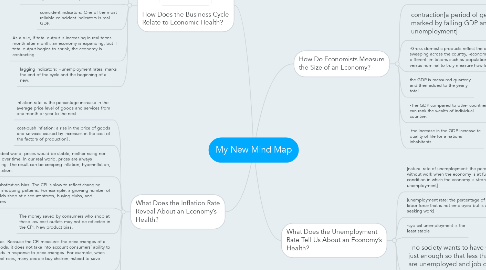My New Mind Map
by Sophie Johnson

1. What Does the Inflation Rate Reveal About an Economy’s Health?
1.1. inflation rate: is the percentage increase in the average price level of goods and services from one month or year to the next.
1.2. cost-push inflation: a rise in the price of goods and services caused by increases in the cost of the factors of production] .
1.3. In an ideal world, prices would be stable, neither rising nor falling over time. In our real world, prices are always changing. The result can be creeping inflation, hyperinflation, or deflation.
1.4. Outlet substitution bias. The CPI is slow to reflect changing trends in shopping patterns. For example, a growing number of households shop at discount stores, buying clubs, and superstores.
1.5. The money saved by consumers who shop at these low-cost outlets may not be reflected in the CPI. New product bias.
1.6. Substitution bias. Because the CPI measures the price changes of a fixed list of goods, it does not take into account consumers’ ability to substitute goods in response to price changes. For example, when the price of beef rises, many people buy chicken instead to save money.
1.7. http://www.wsj.com/articles/inflation-is-low-but-u-s-consumers-still-feel-a-pinch-1436727650
1.8. This link showcases the strengths and weaaknesses of America in the growing market. The inflation rates have made America stronger however in regards to foreign commerce, international goods may be cheaper investments. Because different governments have less regulation possibly to the dismay of foreign company workers it is cheaper for them to trade more in comparison with the us economy which in turn could decrease the competition between the highest GDP in the world.
2. How Does the Business Cycle Relate to Economic Health?
2.1. Business cycle: a recurring pattern of growth and decline in economic activity over time] . -there are four segments to the busuines cycle :expansion, trough, peak, contraction, trough.
2.2. economic indicators: anything used to predict the different changes in the economy, - inflation rate, gdp, unimploymen rate
2.3. leadin indicators: measure the months prior to economic expanision or contraction. The bureu of housing starts is an example.
2.4. coincident indicators: One of the most reliable coincident indicators is real GDP.
2.5. As a rule, if total output is increasing in real terms month after month, an economy is expanding, but if total output begins to shrink, the economy is contracting
2.6. lagging indicators: =unemployment rates. marks the end of the cycle and the beginning of a new.
3. How Do Economists Measure the Size of an Economy?
3.1. Expansion[expansion: a period of economic growth]
3.2. contraction[a period of general economic decline marked by falling GDP and rising unemployment]
3.3. -Gross domestic products reflect the current inflation or deflation sweeping across the country, -economists measure the GDP with different limitations such as population or comparing the real versus nominal to truly measure how large the economy is.
3.4. the GDP is measured quarterly and then added to the yearly total.
3.5. -The GDP compared to other countries can rank the wealth of individual countrie.
3.6. -the increase in the GDP increase te quality of life for a nations inhabitants.
4. What Does the Unemployment Rate Tell Us About an Economy’s Health?
4.1. [natural rate of unemployment: the percentage of the labor force without work when the economy is at full employment; a condition in which the economy is strong and there is no cyclical unemployment]
4.2. [unemployment rate: the percentage of the labor force that is not employed but is actively seeking work]
4.3. -cyclical unemployment is the least stable
4.4. - no society wants to have 0% unemployment just enough so that less than five % of people are unemployed and job changes may be easier.
4.5. every month the BLS reports the number of people unemployed the previous month to keep track of the change in employment rates.
4.6. in an ideal economy, frictional unemployment would not exist.


